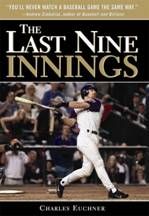March 19, 2006
Amateur Book Review: The Last Nine Innings by Charles Euchner
Baseball is really, really hard.
It’s difficult to understand, oftentimes difficult to appreciate, and always difficult to play.
This is not shocking news to anyone. It is however, the central premise behind this book. The game in present form is over a century old, and ingrained in the American character. Yet, it seems as much a mystery to us in 2006 as it was to those in 1906. What does it take to throw a baseball 95 miles an hour, to make it curve or slide, fall away or cut in? How does one, to paraphrase Pete Rose, take a round ball and a round bat and hit it square? How do we measure defense? What is the difference between a Gold Glove defender and a should-be DH? Euchner picks the brain of hundreds, from players and scouts to statheads and research scientists to try to find the answers.
Does he? Is it even possible?
Maybe and… probably not.
Eucher uses the drama of the seventh game of the 2001 World Series as a backdrop. That series, between the Arizona Diamondbacks, a young team of old men and the New York Yankees –shooting for a fourth championship in a row- came just six weeks after 9/11, and it was both cathartic and ridiculously exciting. It wasn’t the best series of the past 25 years, but coming after the horror of 9/11 and the wound inflicted on New York and America, it may have been the most important. The Yankees had won games 5 and 6 in dramatic fashion, with game-winning homers off Arizona closer BK Kim. The Last Nine Innings switches between a narrative of the final game and exploration of baseball itself.
This is both the strength and the weakness of this book. The game, whether it leads to a examination of Roger Clemens’ perfect pitching form or a discussion about whether Derek Jeter is one of the best fielding shortstops or the one of the worst, always grounds the more esoteric or technical discussion. It can also slow the narrative of both. While the author does a fine job of connecting the two, say a introduction of Roger Clemens and his insane training regiment which leads to a possible explanation for his late-career success and then picks up on the mound near the end of his start in game 7. But it can also meander, and the in-game action is sometimes absurdly slow.
This book, despite clocking in at a mere 288 pages, is neither a quick or easy read. It requires concentration and it helps to either have some understanding of modern statistical analysis or at least an open mind to it. In that respect, I’m probably the perfect audience: a baseball fanatic who understands the importance of modern stats, but has neither the brainpower nor wish to create my own. Meaning: I get what DIPS and OPS and VORP are, but please don’t make me do the math.
The Last Nine Innings is very much a worthwhile read for both the serious fan and the semi-serious. It would serve as a primer, I think, for those wanting to make the jump from one to the other.
Posted by Frinklin at March 19, 2006 11:31 PM | TrackBack